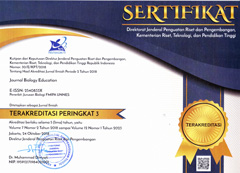The Effectiveness of Blended Learning Models toward The Motivation and Learning Outcomes of High School Students in Ecological Materials
Abstract
Technological advancement is one aspect that can be used to support the learning process. Through the use of technology, one of them is by applying blended learning models students get new experiences that will help them in understanding the material. This study aims to examine the effectiveness of blended learning models on the motivation and learning outcomes of Don Bosko High School students on ecological materials. This research is an experimental research using quasi experiment nonequivalent control group design. Population of students in grade X mipa at Don Bosko High School. The samples used were class X MIPA 2 as experimental class and X MIPA 3 as control class. Sampling using puspossive random sampling. The independent variable in this study is the model of blended learning of ecological material, the dependent variables are the motivation of learning and learning outcomes. The results showed that the percentage of students' learning motivation in the experimental class was 96% while in the control class 84.62% were in a very good and good category. Cognitive learning outcomes in the experimental class were higher than the control class with 84% of students achieving the established KKM. Improved learning outcomes in the experimental class showed moderate categories, while in the control class was in the low category. These results were reinforced by a questionnaire of student responses that gave a positive response to the blended learning model. Based on the results of the study, it was concluded that the blended learning model of ecological material is effective against the motivation of learning and student learning outcomes.
The copyright of the article once it is accepted for publication shall be assigned to the journal as the publisher. The intended copyright includes the right to publish the article in various forms (including reprints). The journal maintains the publishing rights to the published articles.
This work is licensed under a Creative Commons Attribution 4.0 International License.







